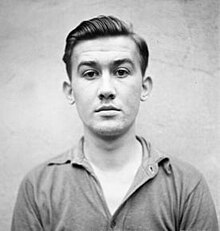Wilhelm Dörr (SS member)
Wilhelm Dörr (born February 9, 1921 in Merenberg , † December 13, 1945 in Hameln ) was a German SS-Oberscharführer and deputy camp leader in the Kleinbodungen subcamp of the Mittelbau concentration camp .
Life
From 1928 Dörr grew up in Emmerichenhain (today the city of Rennerod ). He was married and had one child. Dörr was a farmer by profession on his father's farm. On December 15, 1940, he volunteered for the German Wehrmacht , but his application for membership was rejected. He then successfully applied to the Waffen SS and completed a qualifying technical course in Dresden . In October 1941 Dörr was transferred to a hospital due to illness. He was then stationed in Oranienburg with the guard ( SS-Totenkopfverbände ) of the Sachsenhausen concentration camp and was transferred to the Dora labor camp in January 1944 as a prospective block leader .
From September 1944 he acted as deputy of the warehouse manager Xaver Starkel of the subcamp Kleinbodungen , a subcamp of Dora-Mittelbau, which was under construction . As of October 1944, this satellite camp comprised around 620 prisoners who had to do forced labor in a rocket repair facility for the A4 surface-to-surface missile (better known as V2) . Dörr's job in Kleinbodungen was essentially to hold roll calls before and after the inmates had to work.
After Franz Hössler ordered the evacuation of the Kleinbodungen subcamp on April 4, 1945 , 610 prisoners under the direction of Starke and his deputy Dörr and 45 SS men left the subcamp on April 5, 1945. Originally the order was to transport the prisoners from Herzberg by train. Due to air strikes, however, Starke decided to transfer the prisoners to the nearest concentration camp, Bergen-Belsen . On April 10, 1945, after some prisoners had already managed to escape, the evacuation transport ended up in a combat zone near Groß Hehlen north of Celle . During the fighting, four to five prisoners were shot by field units because they attempted to flee and the march was too slow. On April 11, 1945, the evacuation transport arrived at the Bergen-Belsen concentration camp with 590 prisoners.
On April 15, 1945, the Bergen-Belsen concentration camp was liberated by British troops who found over 10,000 dead and around 60,000 survivors there. The SS camp personnel were obliged to remove all corpses and bury them in mass graves .
Thereafter, Dörr was arrested and interrogated by British military personnel. In the Bergen-Belsen trial (September 17 to November 17, 1945) he was charged with the crimes committed on the death march . According to witness statements, Dörr is said to have shot prisoners during the evacuation march.
Dörr, who pleaded “not guilty”, was found guilty on November 17, 1945 and, like Starkfel, sentenced to death by hanging . The British executioner Albert Pierrepoint carried out the sentences on December 13, 1945 in Hameln prison .
In Emmerichenhain there was also a memorial stone for Willi Dörr at the memorial for those who died in World War II. The stone was removed in 2010.
literature
- Carsten and Wolfgang Gerz: A shot in the back of the head. The story of the war criminal Wilhelm Dörr , writing workshop SCHRIFT: gut, Westernohe 2010, ISBN 978-3-9813391-2-3 .
- United Nations War Crimes Commission (Ed.): Law reports of trials of war criminals, selected and prepared by the United Nations War Crimes Commission. 3 volumes, William S. Hein Publishing, Buffalo (New York) 1997, ISBN 1-57588-403-8 (reprint of the original edition from 1947–1949)
- Jens Christian Wagner: Kleinbodungen sub-camp. In: Wolfgang Benz , Barbara Distel (eds.): The place of terror . History of the National Socialist Concentration Camps. Volume 7: Niederhagen / Wewelsburg, Lublin-Majdanek, Arbeitsdorf, Herzogenbusch (Vught), Bergen-Belsen, Mittelbau-Dora. CH Beck, Munich 2008, ISBN 978-3-406-52967-2 .
Web links
- Mazal: First Bergen-Belsen Trial: Protocols - Dorr's statement on October 23, 1945 ( memento of January 7, 2008 in the Internet Archive )
- Photos and features of the defendants
- Wilhelm Dörr on www.buchenwald.de
- If that goes wrong with the war, God help us - Wilhelm Dörr accompanied the 1945 concentration camp death march near Ohof - the biography of the SS man is almost complete . Info www.newsclick.de from June 17, 2008.
Individual evidence
- ^ Jens Christian Wagner: Kleinbodungen satellite camp. In: Wolfgang Benz , Barbara Distel (eds.): The Place of Terror - History of the National Socialist Concentration Camps , Volume 7, Munich 2008, p. 317.
- ^ A b Mazal: First Bergen-Belsen Trial: Protocols - Dorr's statement on October 23, 1945 ( Memento from January 7, 2008 in the Internet Archive )
- ^ A b Jens Christian Wagner: Kleinbodungen satellite camp. In: Wolfgang Benz , Barbara Distel (eds.): The Place of Terror - History of the National Socialist Concentration Camps , Volume 7, Munich 2008, p. 316 f.
- ^ Andrè Sellier: Forced Labor in the Rocket Tunnel - History of the Dora Camp , Lüneburg 2000, p. 395
- ↑ Karin Orth: The Concentration Camp SS , Munich 2004, p. 265f.
- ↑ Working group tracing - National Socialism in the Westerwald: Remembering for the future - 60 years after the liberation from Nazi rule in the Westerwald (PDF; 817 kB), Montabaur 2005, p. 13f
- ↑ http://www.cellesche-zeitung.de/Celle/Aus-der-Stadt/Celle-Stadt/Gedenkstein-fuer-Kriegsverbrecher-Doerr-entfernt
| personal data | |
|---|---|
| SURNAME | Dörr, Wilhelm |
| ALTERNATIVE NAMES | Dorr, Wilhelm |
| BRIEF DESCRIPTION | German SS Rottenführer |
| DATE OF BIRTH | February 9, 1921 |
| PLACE OF BIRTH | Merenberg |
| DATE OF DEATH | December 13, 1945 |
| Place of death | Hamelin |

